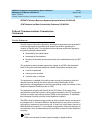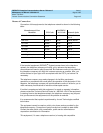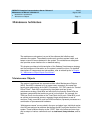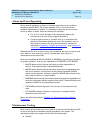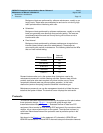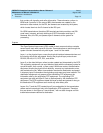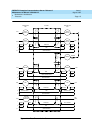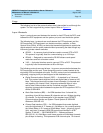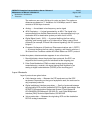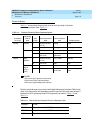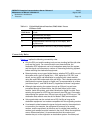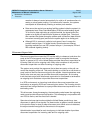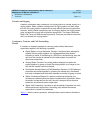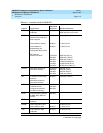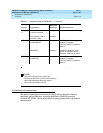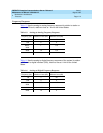
DEFINITY Enterprise Communications Server Release 6
Maintenance for R6vs/si
555-230-127
Issue 1
August 1997
Maintenance Architecture
Page 1-7Protocols
1
The maximum user rate is 64 kbps for voice and data. The maximum
distances are based on T1 limitations. At 2.048 Mbps, each E1 frame
consists of 32 64-kbps channels
■
Analog
— A modulated voice-frequency carrier signal
■
ADU Proprietary
— A signal generated by an ADU. The signal is for
communication over limited distances and can be understood only by a
destination ADU or destination system port with a built-in ADU
■
Digital Signal Level 1 (DS1)
— A protocol defining the line coding,
signaling, and framing used on a 24-channel line. Many types of trunk
protocols (for example, PRI and 24th-channel signaling) use DS1 protocol
at layer 1
■
European Conference of Postal and Telecommunications rate 1 (CEPT1)
— A protocol defining the line coding, signaling, and framing used on a
32-channel line. Countries outside the United States use CEPT1 protocol
Inside the system, data transmission appears in one of two forms:
1. Raw digital data, where the physical layer protocols, like DCP, are
stripped at the incoming port and reinserted at the outgoing port.
2. Pulse Code Modulation (PCM)-encoded analog signals (analog
transmission by a modem), the signal having been digitized by an
analog-to-digital coder/decoder (CODEC) at the incoming port.
Layer-2 Protocols
Layer-2 protocols are given below:
■
8-bit character code
—
Between the DTE equipment and the DCE
equipment. Depending on the type of equipment used, the code can be
any proprietary code set.
■
Digital multiplexed interface
proprietary — Family of protocols between
the originating DCE and the destination DCE for digital transmission. See
DEFINITY Communications System and System 75 and System 85
DS1/DMI/ISDN PRI Reference
, 555-025-101; and
Digital Multiplexed
Interface [DMI] Technical Specification,
555-025-204
■
Voice-grade data
— Between the originating DCE and the destination
DCE for analog transmission



